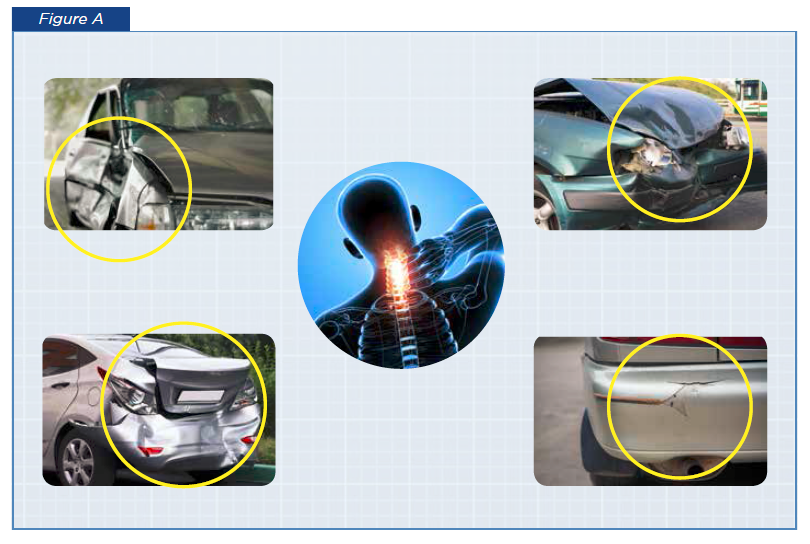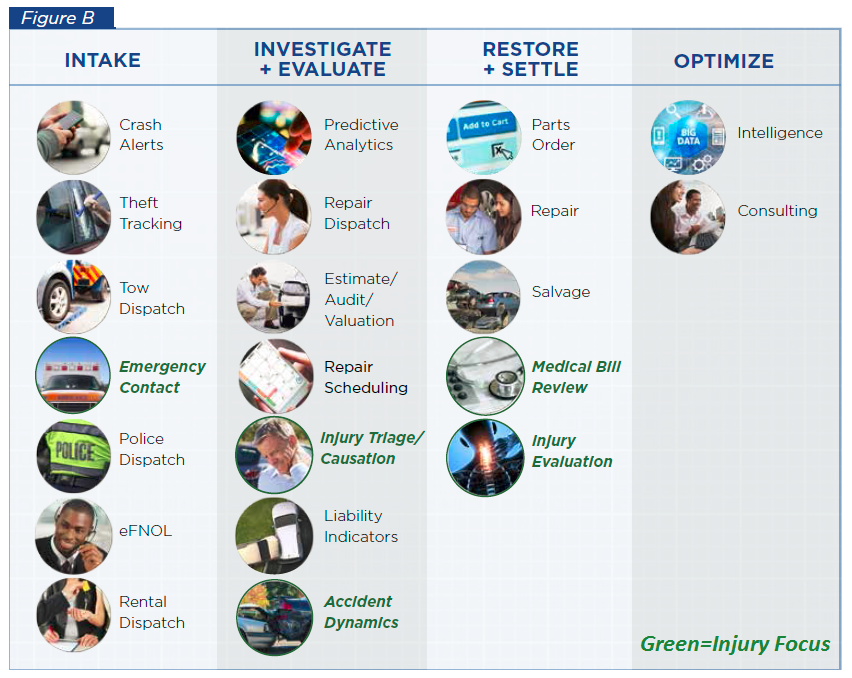Since the first cars were sold, there have been crashes.
And while the insurance claims industry has made enormous advances over the years, the fundamental process of handling a claim has been largely the same for decades at least during my time in this industry, which spans nearly 30 years, and includes research and work in claims and the application of “black box” information in the evaluation of liability and injury causation.
A crash occurs. At some point later, the insured or claimant calls an insurer's first notice of loss department. Collected facts about the accident are used to make initial assignments for vehicle inspection and claim handling. For both auto physical damage (APD) and casualty claims, a variety of steps follow to set appropriate reserves, investigate the claim, monitor the restitution processes and settle the claim. And throughout these steps, speed, accuracy and customer satisfaction are the gold standards for performance.
How far could you transform that process if you had detailed, sensor-based information about the crash at the exact time it occurred? By integrating telematics and driving data into the claims process, you can do exactly that. Let's examine the possibilities.
|Reinventing first notice of loss
Imagine a process where upon impact, your first notice of loss (FNOL) team is notified that a policyholder has been in an accident, and the facts of that accident pre-populate a loss intake screen. Gone would be the need for Q&A scripts, and in their place would be interactive FNOL, a process that enabling the proactive management of the accident scene. Consequently, you could provide even better customer service, and achieve better outcomes in terms of claim resolution speed and accuracy.
Within a minute of the collision, the vehicle automatically contacts your FNOL department and gives you the date, time of loss and provide information about the insured, the vehicle and coverages. Based on GPS data transmitted, your systems provide the exact accident location, color-coded tracking is provided to show where the vehicle was traveling prior to the accident event, where the vehicle traveled in the five seconds immediately preceding the accident, and the estimated point of impact and the post-collision movements of the insured's vehicle.
Armed with this information, you automatically contact your insured, gather any additional information about the accident and potential injuries and assure them help is on the way. Your team simultaneously alerts and dispatches necessary emergency services, providing them with known information about the accident and potential for injury.
Let's now step back and examine what just happened. Your claims organization has just fundamentally changed the relationship with your insured. You have provided time-critical, potentially life-saving services to the insured and/or insured's family in a true emergency.
|Transforming APD Claims
In addition to emergency services, numerous other transformational capabilities can be deployed in the claim process. For example, based on the accelerometer and point-of-impact data, analytics can determine the likelihood of the vehicle being drivable, as well as the likelihood of the vehicle being repairable versus a total loss. It is also possible to arrange for a rental car to arrive at the accident scene. When the towing service provider arrives, based on analytics of the data from the vehicle, the tower completes a series of complementary investigative tasks which were automatically generated and transmitted when the assignment was made.
Coupled with the data from the insured's vehicle, the claim organization will now have the essential information to reconstruct the accident and assess liability within minutes.
From a repairer perspective, access to more information about the accident can have a positive impact on cycle time, efficiency and customer satisfaction. Repairs could be scheduled before a car even arrives at the shop, and the essential parts to repair the vehicle could be ordered earlier in the process from the most cost-effective source within minutes of the accident rather than in days, reducing unnecessary time and expenses associated with multiple tows and storage.
|Integrating with casualty claims
Later, in the management of claims, these metrics offer the capability to examine results based on similar accident and injury events.
For example, in the various accident types shown in Figure A, it is possible for an occupant to experience a neck strain injury. Would management expect a neck strain to settle for the same amount for these different impact scenarios? Clearly no.
Through the use of acceleration and impact direction data, claim resolutions can be reviewed based on the same types of events in terms of impact direction and severity. This approach is an important distinction from reporting capabilities today. Today, the industry can review the average cost of a neck sprain/strain in a given jurisdiction. The state of tomorrow will allow us to review the average cost of a neck sprain/strain in a given jurisdiction for the same type and severity of impact. The key is linking auto physical damage data to casualty data. Our research tells us that the fundamentals to linking APD data to casualty data is recognizing and capturing the key common denominators to the data (assuming, of course, that you have sufficient quantities of data).

Since the same collision event creates the auto physical damage, the injury and the accelerations, it is logical to examine all of this data when analyzing the implications of linking the data.
Based on these data relationships and data created and captured by CCC technologies today, smart analytics can inform claim decisions and processes in a simple and non-disruptive way.
- When telematics are integrated with claims:
- Telematics data create the myriad opportunities to improve claims processes and outcome for both auto physical damage and casualty claims (Figure B).
- Telematics data ultimately helps determine the cause (both liability and legitimacy) and severity of both auto physical damage and injury claims.
- The framework for how claims performance is measured and subsequently improved.

Scott Palmer is a product innovation consultant and former senior vice president for products and technology at CCC Information Services. Contact him at [email protected].
Want to continue reading?
Become a Free PropertyCasualty360 Digital Reader
Your access to unlimited PropertyCasualty360 content isn’t changing.
Once you are an ALM digital member, you’ll receive:
- Breaking insurance news and analysis, on-site and via our newsletters and custom alerts
- Weekly Insurance Speak podcast featuring exclusive interviews with industry leaders
- Educational webcasts, white papers, and ebooks from industry thought leaders
- Critical converage of the employee benefits and financial advisory markets on our other ALM sites, BenefitsPRO and ThinkAdvisor
Already have an account? Sign In Now
© 2024 ALM Global, LLC, All Rights Reserved. Request academic re-use from www.copyright.com. All other uses, submit a request to [email protected]. For more information visit Asset & Logo Licensing.





